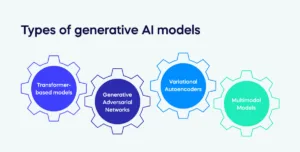What is Generative AI?
The digital landscape has witnessed drastic evolution right from static pixels to virtual concepts and artificial intelligence. Images and texts in static pixels were very confined to their visual form and lacked to ability to adapt or comprehend. However, with the integration of AI, pixels have become a way out to cognitive processing, enabling machines to learn, interpret, and respond to visual content.
Generative AI is a promising emerging AI technology that plays a key role in how digital content is created, manipulated, and interpreted. It uses neural networks and deep learning to identify patterns and algorithms in existing data and creates new images, texts, music, audio, and videos.
Generative AI models are trained to distinguish small-scale and overachieving patterns in training datasets through sources like the internet, image libraries, books, websites, and code repositories as well as from social media platforms, blogs, and forums. This training enables different models to mimic patterns and create unique and novel content close to human-generated work.
In recent times, generative AI has been used across various industries such as advertising, e-commerce, education, gaming, marketing, surveillance, media, and podcasting for different applications, and top players and companies are heavily investing in research and development activities to explore its potential applications.
Types of Generative AI Models:
Generative AI typically encompasses several techniques and models that help in generating fresh, unique data or content that nearly resembles human-created. Individuals and companies can generate images and original video content and synthesize audio, speech, and synthetic data, depending on the type of generative AI model they are working with.
Several types of generative AI models are in the market today and the number is growing with each passing day as AI experts and key opinion leaders are working on enhancing the capacities of existing models. Some of the most commonly used generative models include:
Generative Adversarial Networks: Generative Adversarial Networks or GANs are neural networks used for unsupervised learning and aim to identify patterns in input data anonymously and help in producing novel data resembling the original dataset through adversarial training. This model does so with the help of two key components; a generator and a discriminator. GANs are best used for synthetic data generation and image duplication.
Transformer-based Models: Transformer-based models use attention mechanisms to handle complex relationships between the data by analyzing all elements simultaneously. These models can manage long sequences allowing faster training and are used for tasks such as text generation and translation.
Variational Autoencoders (VAEs): VAEs encode data into a latent space and later decode it back to recreate the original content and are typically used in tasks associated with image generation and text and audio generation.
Recurrent Neural Networks (RNNs): RNNs process sequential data such as time series data and natural language sentences by predicting the next element in the sequence.
Neural Radiance Fields (NeRFs): NeRFs serve as a powerful tool with the integration of generative AI. This is widely used in tasks that involve rebuilding complex 3D structures from a partial set of 2D images.
Potential Role of Generative AI in Transforming the Future:
Generative AI has already proven to be a valuable asset for medium to large-scale organizations to save time, and money, enhance quality content, and increase overall efficiency and many companies are exploring ways to use these models to create high-quality and engaging content and solve problems with better possible outcomes and solutions. Apart from content creation and automation, it can help businesses improve consumer experience, data analysis, risk mitigation, marketing, and coding as well as develop new products.
Generative AI is rapidly gaining traction across the creative industries to create music, art, and other forms of creative content. People in this industry are relying on these models for improved quality content, automated content creation, and better content variety. It is used in the pharma and healthcare sectors to analyze huge drug databases and foresee potential synergies among drugs and candidates. It also allows scientists and researchers to develop safer and more effective products, thereby reducing the risks associated with adverse side effects and increasing the outcomes.
Drawbacks of Generative AI:
Generative AI is making remarkable changes in the digital world, but it still retains certain challenges. In context to content creation, generative models can be misused by hackers and manipulators to create deepfake content, raising ethical concerns related to privacy and misinformation. Plus, the AI-generated images or text can reflect racial or gender biases, leading to unfair or harmful representations. These also require large databases and quality data for accurate interpretation. Thus, limited or poor information or data can lead to inaccurate outputs.
One of the biggest drawbacks of generative AI is its use in academics to write essays and solve problems. Students and educational institutes completely relying on these tools can hamper their critical thinking and problem-solving experiences.
Though generative AI is in its early stages, the costs associated with infrastructure, software, expertise, and other resources are significantly high. This can limit the adoption of generative AI in businesses and sectors that have limited budget spending capacity. Moreover, these systems are vulnerable to breaching and phishing.
Role of Companies in Overcoming the Challenges:
To overcome the above challenges, leading technology companies are focused on investing in R&D activities to launch advanced and more secure generative AI models and algorithms that can easily identify and mitigate potential threats. They are also collaborating and partnering with other companies and institutes to develop advanced APS and user-friendly interfaces. Moreover, many manufacturers and tech companies are establishing ethical principles and guidelines to ease processes and product security.
Also Read:
Unleashing Potential: AI Consulting Reshaping Development Horizons


